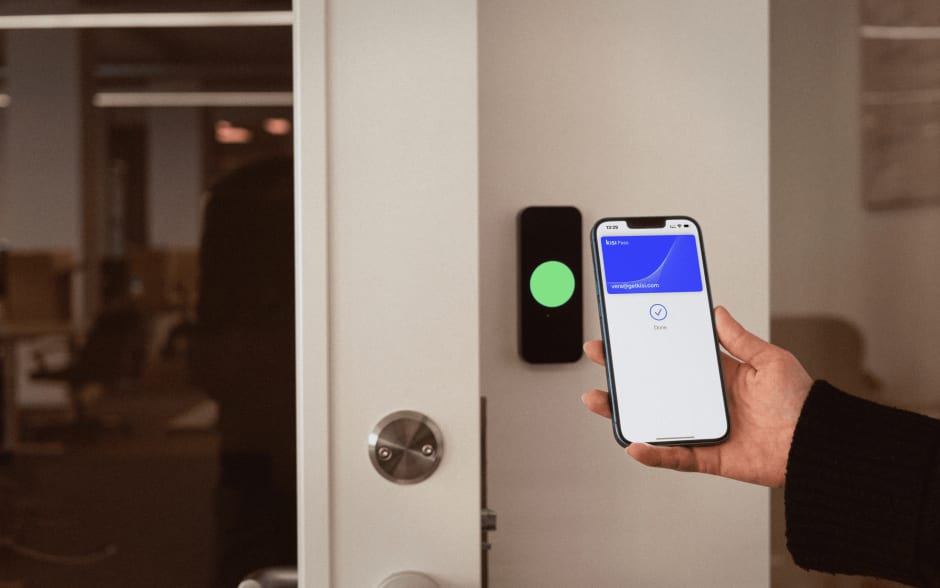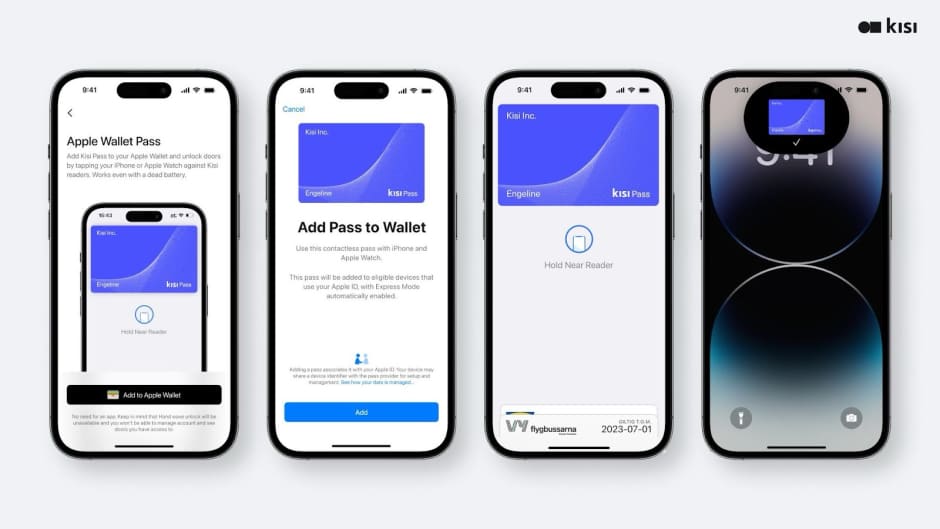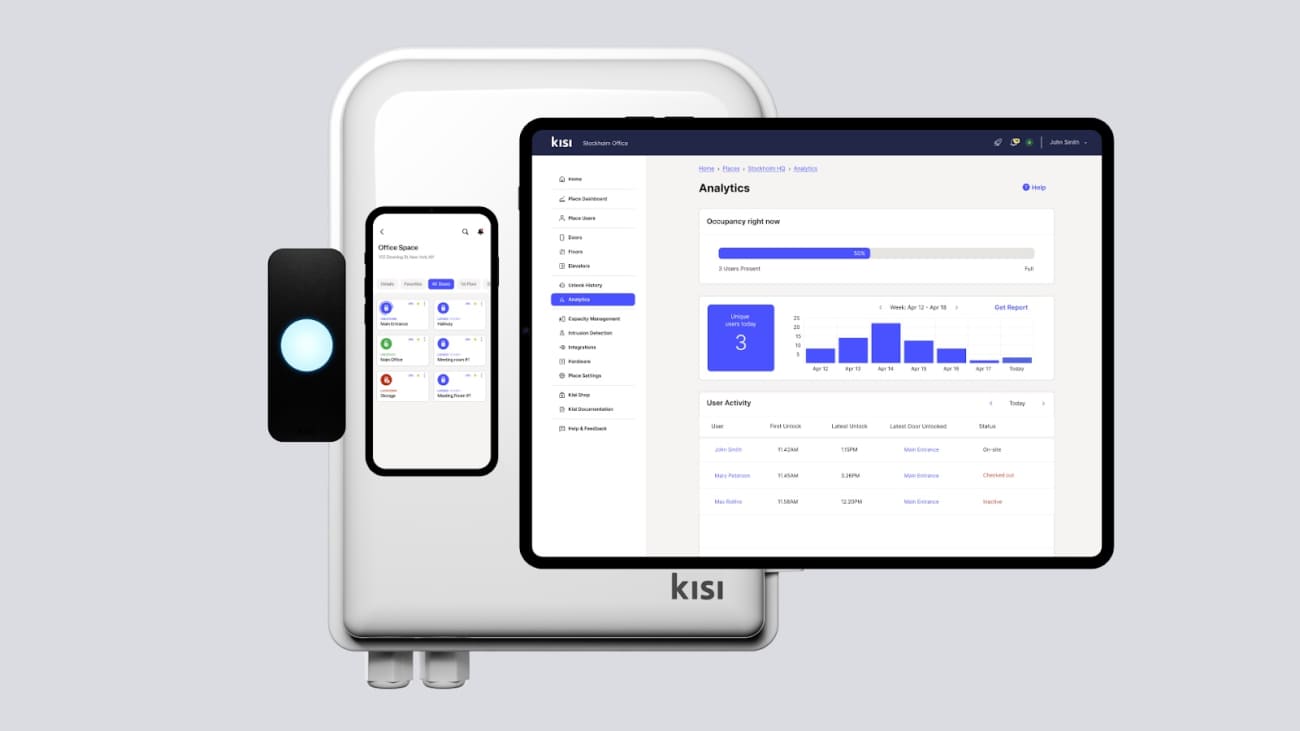An employee badge is so much more than a way to display an employee’s name and photo. With the right systems and tools, your employees’ identification cards can support better attendance tracking, space utilization, and security. Unfortunately, some companies remain stuck in the past, limiting their employee badges to pieces of plastic with very little purpose.
Issuing more advanced employee ID badges might require some new hardware and software, but the effort is well worth it in the end. This article will help you understand how employee badges work, what kinds you can use, and why they’re an essential tool for every business, no matter your industry, size, or location.
What are employee badges? #
Employee badges are identification cards that organizations issue to workers. Depending on their type and features, they can enable employees to display their personal information, unlock doors, and confirm they’re present and on-time for work.

The early days of employee IDs #
The earliest employee badges were simple, laminated paper cards with a person’s name, job title, and employee number. People often wore them on lanyards or clipped them to their clothes so they could quickly present them whenever necessary.
Over time, organizations began using plastic cards and adding more information, including photos. Eventually, many companies transitioned to badges with magnetic stripes, barcodes, and radio frequency identification (RFID) chips. These cards allowed employees to not only identify themselves but also to unlock doors and access critical business systems.
Types of employee badges in use today #
You can break down modern employee badges into two broad categories: physical and digital. Several types of cards fall under the umbrella of physical employee badges:
- RFID employee badges use radio frequency identification technology to store and transmit data. Employees hold their cards up to an RFID reader to trigger a reaction, like unlocking a door.
- You can swipe a magnetic card through a reader to transmit information. However, these cards are more prone to damage and failures because the magnetic strip can wear away.
- With barcode employee badges, workers scan their cards with a barcode reader. Their encoded information is transmitted to the system for verification and authorization.
These traditional employee badges remain in use today, but many organizations have recognized their limitations and turned to digital alternatives.
Digital employee badges contain the same kind of information as traditional cards, but they store it on a mobile device rather than a physical object. Employees usually access their digital badges through an app. They offer the same conveniences as physical cards, with the added bonus of being more accessible and cost-effective.

The addition of employee badges to Apple Wallet #
One of the most transformative developments in the world of worker identification cards is the introduction of employee badges in Apple Wallet. All the 1.382 billion people who own iPhones have Apple Wallets, which they can use to store everything from credit cards to concert passes to airplane tickets.
With the addition of employee badges, the Apple Wallet is a convenient and secure storage method for worker information. By implementing an access control system like Kisi, employees can use the badges saved in their Apple Wallets on both their phones and watches.
When they need access a space, they only have to hold up their devices to use their Apple Wallets to unlock doors. The ability to access an employee badge through both a phone and a smartwatch is especially helpful, considering that almost 80% of iPhone users also have an Apple Watch.
Applications for employee badges #
Old school employee badges might have served only one purpose—displaying a person’s name and title—but today, they have wide-ranging uses. These are some of the most common applications:
- Employee identification: Employees can show their badges to colleagues, guests, and clients to verify their position and authority.
- Time and attendance tracking: Workers can clock in at work using their employee badges by running them through a system with attendance tracking capabilities.
- Unlocking doors: Some employee badges allow people to unlock doors or barriers, including primary building entrances, turnstiles, elevators, and interior office doors.
- Certifications: Employees who have earned professional certifications or certificates can store that data on some badges, particularly digital ones.
- Employee recognition: You can celebrate your workers’ accomplishments and milestones by adding markers or special symbols to their digital employee IDs.
- Personal information storage: An employee badge can hold other details, such as personal contact information and the names and phone numbers of emergency contacts.
- Branding: Whether they’re physical or digital, you can strengthen your organizational branding by creating custom employee badges with your company logo, color scheme, fonts, and motto.
With so many potential functions, using secure, effective, and convenient employee badges has never been a wiser investment.
Advantages of using employee badges #
Although they might seem trivial compared to other employee equipment and tools, such as laptops and tablets, employee ID badges can improve your business operations on multiple fronts. In terms of security, accountability, and efficiency, even the smallest organizations can benefit from issuing badges to their employees.
Enhanced security and access control #
Access control is a central component of any comprehensive business security system—but only if it’s straightforward and consistent. If employees forget to lock doors behind them or lose their keys, they introduce a security threat.
Rather than using separate keys or fobs to unlock doors, you can incorporate access control technology into your employee badges. This makes it easier to prevent unauthorized individuals from entering restricted spaces in your business. In addition, employee badges used in conjunction with a badge access door system like Kisi allow you to separate areas within your business based on authorization levels.
For example, many businesses have employee-only areas that customers or clients can’t enter, and they use access control paired with employee badges to restrict access to them. However, you may also need to limit who can access specific rooms in your building. Adding authorizations based on employee job titles and training means you can add extra protection to areas with sensitive or confidential information. Only employees with permission to access that data can use their employee badges to enter.
Another advantage of pairing employee badges with an access control solution is your ability to stay on top of incidents on-site. If someone tries to enter your building without scanning a valid badge, the system can trigger intrusion alerts so business leaders and emergency responders can react quickly and minimize damage.

Streamlining attendance tracking #
Employee badges tied to an advanced access control system that supports attendance tracking also let you know when and how long employees are on the premises. Hybrid offices that require certain in-office attendance can greatly benefit from this kind of system. Another use case is tracking time for hourly employees to help prevent issues with payroll. For instance, when employees scan their badges to unlock the door, you’ll know they’ve arrived at work. You also monitor when they leave for and return from lunch and when they end their day based on their badge use.
This kind of attendance tracking also increases employee accountability, and it’s much simpler than having employees use sign-in sheets or separate clock-in systems. Employees won’t forget to clock in and out each day because their attendance will automatically be recorded when they enter and exit the building. If you’re concerned about buddy punching, consider implementing digital employee badges.
Improving overall efficiency #
Employee badges can also enhance your business operations as a whole. These are some of the specific improvements you might see:
- Supporting employee morale and productivity by creating a feeling of belonging and community while also reflecting your organization’s focus on employee safety and comfort
- Offering insights into space utilization so you can optimize scheduling and desk assignments for hybrid or part-time workers
- Reducing or eliminating the need for constant on-site security or front desk attendants
- Mitigating security and safety risks that could disrupt your day-to-day operations
When you use them properly, employee badges can create a more positive experience for everyone involved with your organization, including employees, customers, and leadership.

What to consider when choosing badges for your business #
Some organizations need highly advanced employee badges, while others are looking for a more basic solution. In either case, knowing how to evaluate the strengths and weaknesses of your options is critical.
Security vulnerabilities #
Employee badges should support your business security—not weaken it. Selecting the right kind of card is the defining factor in how successfully you protect your organization.
Generally speaking, digital employee badges are more secure than physical ones. If someone steals a physical badge or an employee loses it, unauthorized individuals can easily gain access to the building. They only have to scan, swipe, or tap the badge to unlock the door, bypassing your access control protections entirely. Unless you have on-site security verifying an employee’s face matches their badge, a physical employee badge system typically can’t confirm that the correct person is using it.
Digital badges and other mobile credentials help close these gaps because they’re difficult, and sometimes impossible, to steal and use without the employee’s permission. Smartphones generally include additional security features, including biometrics and passcodes. Requiring employees to use these security measures prevents anyone who isn’t the employee from using it to unlock the door.
This higher level of security is important for any kind of business, but it’s especially critical for those with valuable physical assets and confidential data. Some organizations are concerned that hackers could access the information saved on digital employee badges. For that reason, look for a digital badge that features encryption, which substantially lowers the risk of data theft.
Replacement costs #
Printing digital badges can quickly get expensive, particularly if you have high turnover rates or frequently add to your team. The type of badge you choose could significantly increase or decrease how much you invest in your employee IDs.
This is one of the most important distinctions between digital and physical employee badges. Employees can easily lose their cards, and they also become damaged over time, particularly with repeated use. When that happens, or when you onboard an employee, your organization has to print new employee cards, a seemingly small cost that can add up quickly.
Digital badges eliminate these expenses because you don’t have to print any physical cards. Instead, you load each employee’s information onto a digital card they carry on their mobile device. Although some digital card systems require a larger upfront investment, digital badges tend to save money in the long run.

Environmental impacts #
Another point to keep in mind when selecting an employee badge is how it will affect the environment. Digital badges are an excellent solution for eco-conscious organizations because you don’t have to waste plastic producing them. Although it’s difficult to pinpoint the exact amount of plastic people and businesses throw away, scientists estimate that only 9% of plastic is recycled each year.
The growing mountains of unrecycled plastics include millions of discarded or damaged employee badges and ID cards. Reducing the number of plastic badges you produce and throw away helps reduce plastic pollution, protecting human life and entire ecosystems. For organizations worried about the health of the planet, digital employee badges are generally the better option.
Upgrade your employee badges with Kisi #
You and your employees both deserve reliable, easy-to-use employee badges that add convenience and security to your operations. As you investigate potential badges, such as RFID, barcode, and digital badges, take a forward-thinking approach to your decision. Finding a future-proof solution you won’t have to replace every few years saves your business precious time, money, and effort.
When you’re looking for a cutting-edge option that promotes better access control, Kisi’s digital employee badges fit the bill. Our access control systems are compatible with a variety of badge types, including digital ones stored on your workers’ smartphones and watches. Schedule a demo to talk to an access control specialist and learn more about Kisi’s employee badges.






